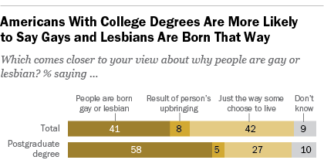On Friday, June 24, 2022, the Supreme Court overturned the landmark Roe v. Wade decision, removing constitutional protections for abortion, and all but ensuring that the procedure will become illegal in over half of states. The question of if—as well as where and when—abortion will be legal, has long occupied the attention of Americans on every side of the issue.
But the announcement of the SCOTUS decision has only heightened the stakes of another, related issue: access to quality sex education. For millions of young people across the country, sex ed is formative for thinking about and knowing how to safely engage in sexual activity, and learning (or not learning) about contraception. Sex education and abortion are also intimately connected in another way; many of the states with the most restrictive sex ed legislation are the states where abortion will be least accessible now that Roe is overturned.
Sex education has long been fraught with moral and political questions, functioning as a point of debate that reflects the cultural events and beliefs of the moment. As with many school subjects, the way sex ed is taught and how people think about its role has changed over the past century, and differs regionally across the U.S.
In order to find out where sex education laws and policies currently stand across the country, Stacker investigated the requirements for teaching sex education in each of the 50 states and Washington D.C. using 2022 data from the Guttmacher Institute and 2021 data from SIECUS, a sex education policy and advocacy organization. States were evaluated according to whether sex and STI/HIV education are required to be taught, whether instruction must be medically accurate, and 11 other criteria.
Trends in sex education throughout the years tend to be taken up by some states, while other states are left behind, according to Elizabeth Nash, the Principal Policy Associate of State Issues at the Guttmacher Institute, a reproductive rights policy and research organization. This results in “patchworks” across the country, where up-to-date, comprehensive policies coexist with the sparse and outdated ones. These policies, according to Nash, range from “incomprehensible” to “comprehensive” to “cruel.”
“Back in the ’90s and the ’80s it was like, ‘Everyone have a condom all the time because of HIV,’” Nash told Stacker in an interview. After that, a wave of abstinence-only education swept the country. “And then it was like, ‘Do we ever talk about contraception? Well, maybe.’” Following these trends was a period where the extent of rampant sexual assault in the U.S. became more clear, leading to a surge in content about violence prevention and consent. “And now it’s gender identity,” said Nash.
It is easy to see how this combination of trends often exists in conflict with itself. Abstinence-only sex education has long been disproven as an effective method of preventing teen pregnancy. It does not—as advocates hope—postpone the start of sexual behavior, nor does it apply to large swaths of teenagers: members of the LGBTQ+ community, teens who are already pregnant or have children, and assault survivors, among others.
In fact, research shows that abstinence-only programs are not only ineffective, but often harmful. States that implement abstinence-only curricula have been shown to have higher rates of teen pregnancy and birth, as well as sexually transmitted diseases and infections. Only 17 states require that sex education be medically accurate, and only 20 (plus Washington D.C.) mandate education about contraceptives. Additionally, these types of programs are often taught using language that ties together premarital sex with shame and stigma, and those engaging in premarital sex—particularly young women—with dirtiness and worthlessness. Many schools have reportedly compared teenage girls who have engaged in sexual activity to chewed up pieces of gum or dirty chocolates.
Both past and current sex education trends often exclude relevant information for LGBTQ+ students, or more directly include language that disparages a “homosexual lifestyle.” So-called “no promo homo” laws—as well as the recent introduction of “Don’t Say Gay” bills in Florida and many other states—not only seek to shame, erase, and demonize LGBTQ+ students, but also neglect to inform them of vital health information. Such decisions are tied to poorer health outcomes for these students.
You may also like: Can you answer these real ‘Jeopardy!’ questions about politics?
![]()







